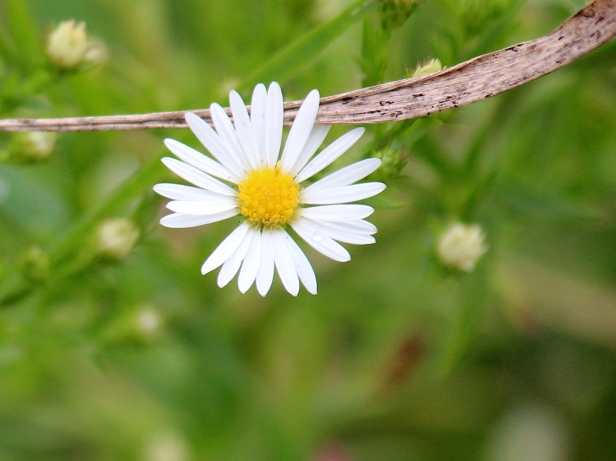Asters
Autumn brings with it a change in wildflowers. Early on, Goldenrod started its golden reign; now, as the season advances, it is joined by another numerous plant, making its presence known in modest white and purple blooms that often fill the landscape.
Asters are a large group of plants. They not only include what we think of as classic Asters, but also sunflowers, coneflowers, daisies and other plants. This grouping is sometimes known as the Composite family. This is because what looks like a single flower is actually a grouping of many little flowers. If you examine them closely, you’ll see that the disk of the flower head is made up of dozens of tiny tubelike flowers; sometimes the rays are tiny flowers as well. Each of these mini-flowers will produce one seed. Nature is remarkable in its various workings!
The word ‘aster’ in Ancient Greek means ‘star’, referring to the flower’s appearance. We tend to think of generic flowers as the typical disk surrounded by rays that makes up the typical Aster. They often remind one of miniature daisies. These flowers have been domesticated and can be found in gardens in the Old and New Worlds as well as in the wild.
Asters are not just popular with gardeners and nature aficionados. They also attract many insects, including lots of butterfly larvae. Ants seem to be attracted to them.
Asters can sometimes be mistaken for fleabane, which look similar, and are a member of the same family. Generally speaking, Fleabane has narrower rays, and its leaves look different. Fleabane is more of a spring and summer flower, but some persist into the autumn.
Classic Asters bloom in the autumn. Their colors range from white to purple. They can be found in fields, along roadsides, fencelines and bike paths, wood edges, and other out-of-the-way places. Certain species can even be found in lightly wooded areas. Generally, Asters like sunshine and can grow in a variety of soil conditions.
A common species is the White Aster, also known as Heath Aster. It has numerous flower heads on each plant, has a plentiful amount of white rays surrounding each yellow disk. It is common to find many of these plants in a field together.
Another common species is Calico Aster, which has a smaller number of rays and differently-colored disks- hence the calico name.
A very distinctive species is the New England Aster. This species is strikingly purple in color, with bright disks. The flower heads are larger on this species than on most other Asters. This roadside wildflower is hard to miss!
There are light purple varieties such as the Heart-leaved Aster. These like a woodland habitat more than other Asters.
Asters help make the autumn season a showier place. They are a good compliment to all of the Goldenrod one sees this time of year. Enjoy them while you can!













Gorgeous flower photos, Tracy. Excellent. 🙂
I love these flowers. I would call them Michaelmas daisies in general. Do you use that name?
I love them too! I’ve heard them called Michaelmas Daisies before, though here in the Midwestern US they’re usually called Asters. I sometimes wonder if I should use the Latin scientific names for the plants I mention, but I try to keep things on the simpler side here. Also that’s half the fun, figuring out what people call wildflowers in different regions and different countries 🙂
Beautiful shots! You are rockin that new camera my friend! Margie
Lovely.
I love asters 🙂 Judy
Beautiful shots and good info. I’ve become enamored of the wild asters that have appeared in a neglected patch of my yard.
Beautiful series of photos! I love asters and have been enjoying them here for about two months now but they are nearly all gone now. They sure brighten things up when most other wildflowers have finished blooming.
Asters are the dominant road-side flower in New Brunswick this time of year. They remind me of bunches of grapes in the ditches! You give a great synopsis of their charm and variety. Photo 100611-8 is my favorite, with the tiny droplets of moisture and shadow detail on the petals. Jane
Thank you…asters are so beautiful. It will be good to return to your photos in our long Wisconsin winter!
Very nice!
I’ve seen these around and have photographed what I now understand was likely fleabane… I thought they were all the same. I learn so much visiting your blog. 🙂
Thanks for identifying the white ones! I was told they were calico daisys. Great photos, and I learn so much from your posts.
We’ve also been seeing a lot of Asters here in Berlin lately… beautiful flowers! 🙂
Another excellent post, Tracy. Your images are beautiful. 🙂
The New England asters are some of my favorite flowers this time of year, especially when they bloom against the brilliant yellows of the goldenrod.
Thank you for this post. I was out the other day taking pictures of these pretty white flowers that have burst into blooms in our woodlands & underbrush. I thought they were the Spring species like the fleabane. Cool I learned something new. I really like knowing they’re Asters. They’re a charming little flowers. Thanks so much. 🙂
Glad I could help! It’s easy to confuse Asters & Fleabane, I’ve done it before- it’s a lot easier in the spring, because only Fleabane is out then 🙂
Hi Watching Seasons, I have seen a few Asters along the roads here in Cumberland County, TN from time to time during the year. I have never seen a Calico Aster in person. Your pictures are great! I especially like those Calico’s because of the variety of the colors of the center disc. Have a most excellent day tomorrow and a great coming weekend!
I’ve been guilty of mistaking fleabane for asters. Thanks for the great pics!
Can you eat them
Some people say so!
http://eatingwild.blogspot.com/2011/03/goldenrod-miracle-wild-food-source.html
http://www.ediblewildfood.com/new-england-aster.aspx